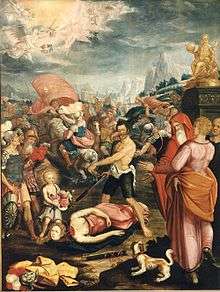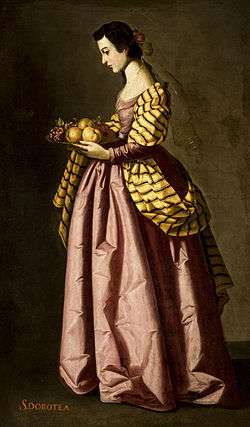Dorothea of Caesarea
| Saint Dorothy of Caesarea | |
|---|---|
|
Saint Dorothy, Francisco de Zurbarán | |
| Died |
~311 Caesarea Mazaca |
| Venerated in | Roman Catholic Church; Eastern Orthodox Church |
| Feast | February 6 |
| Attributes | flowers and apples |
| Patronage | horticulture; brewers; brides; florists; gardeners; midwives; newlyweds; love; Pescia[1] |
Saint Dorothy (Dorothea, Dora; Italian: Santa Dorotea, Spanish: Santa Dorotea; died ca. 311) is a 4th-century virgin martyr who was executed at Caesarea Mazaca. Evidence for her actual historical existence or acta is very sparse. She is called a martyr of the Diocletianic Persecution, although her death occurred after the resignation of Diocletian himself. She should not be confused with another 4th-century saint, Dorothea of Alexandria.
She and Theophilus are mentioned in the Roman Martyrology as martyrs of Caesarea in Cappadocia, with a feast day on 6 February.[2] She is thus officially recognized as a saint, but because there is scarcely any non-legendary knowledge about her, she is no longer (since 1969) included in the General Roman Calendar.
Life
.jpg)
The earliest record that mentions Dorothea is found in the Martyrologium Hieronymianum. This first record contains only three basic facts: the day of martyrdom, the place where it occurred, and her name and that of Theophilus.[3]
Legend
Virgin and martyr, suffered during the persecution of Diocletian, 6 February, 311, at Caesarea in Cappadocia. She was brought before the prefect Sapricius, tried, tortured, and sentenced to death. On her way to the place of execution the pagan lawyer Theophilus said to her in mockery: "Bride of Christ, send me some fruits from your bridegroom's garden." Before she was executed, she sent him, by a six-year-old boy, her headdress which was found to be filled with a heavenly fragrance of roses and fruits. Theophilus at once confessed himself a Christian, was put on the rack, and suffered death. This is the oldest version of the legend, which was later variously enlarged.[4]
The oldest known version of the legend is Aldhelm's De laudibus virginitatis, addressed to Abbess Hildelitha of Barking Abbey, Essex. Kirsten Wolf characterizes it as one of several legends invented in the fourth and fifth centuries to provide a story to go with a name on one of the various liturgical calendars.[5]
Veneration
In the West she has been venerated since the seventh century. Dorothy's cult became widespread in Europe during the Middle Ages.[6] In late medieval Sweden she was considered as the 15th member of the Fourteen Holy Helpers,[6] and in art she occurred with Saint Barbara, Catherine of Alexandria and Margaret of Antioch, forming with them a quartet of female saints called de fyra huvudjungfrurna or in Latin, "Quattor Virgines Capitales" meaning "The four Capital Virgins"
Patronage
She is regarded as the patroness of gardeners. On her feast (February 6) trees are blessed in some places.[4] She is also patroness of brewers, brides, florists, gardeners, midwives, newlyweds and Pescia, Italy
Iconography
Dorothea is represented with an angel and a wreath of flowers.[4]
She is often depicted as a maiden carrying a basket of fruit and flowers, especially roses; also depicted wearing a crown of flowers (such as roses); depicted surrounded by stars as she kneels before the executioner; crowned with palm and flower basket, surrounded by stars; depicted in an orchard with the Christ-child in an apple tree; leading the Christ-child by the hand; veiled with flowers in her lap; depicted holding apples from heaven on a branch[1]
Legacy
The Congregation of the Sisters of Saint Dorothy is a convent of active nuns, occupied primarily with teaching and the cultivation of flowers and produce. The order is named for Dorothea of Caesarea.
Dorothy of Caesarea's life and martyrdom was the basis of Philip Massinger and Thomas Dekker's The Virgin Martyr (printed 1622).
Depictions
 Saint Dorothy, by Lucas Cranach the Elder.
Saint Dorothy, by Lucas Cranach the Elder. Saint Dorothy by Girolamo Donnini
Saint Dorothy by Girolamo Donnini The Martyrdom of Saint Dorothea by Josse van der Baren
The Martyrdom of Saint Dorothea by Josse van der Baren- Dorothea by Andrea della Robbia
 Stained glass representing St. Dorothea of Caesarea. Upper Rhine, ca. 1450
Stained glass representing St. Dorothea of Caesarea. Upper Rhine, ca. 1450 The Decapitation of Saint Dorothy, Hans Baldung Grien
The Decapitation of Saint Dorothy, Hans Baldung Grien- Saint Dorothy and the Angel by Alessandro Tiarini
- Fresco from anonymous painter 15th century Brixen school (Italy)
See also
- Sainte-Dorothée, Quebec, a borough in Laval, Quebec, Canada
| Wikimedia Commons has media related to Saint Dorothy. |
Notes
- 1 2 Patron Saints Index: Saint Dorothy of Caesarea
- ↑ Martyrologium Romanum (Libreria Editrice Vaticana 2001 ISBN 88-209-7210-7)
- ↑ Joseph Martin Peterson, The Dorothea Legend: Its Earliest Records, Middle English Versions, and Influence of Massinger’s "Virgin Martyr" (University of Heidelberg, 1910), 13.
- 1 2 3 Meier, Gabriel. "St. Dorothea." The Catholic Encyclopedia. Vol. 5. New York: Robert Appleton Company, 1909. 13 Mar. 2015
- ↑ Wolf, Kirsten. De Sancta Dorothea, PIMS, 1997 ISBN 9780888441300
- 1 2 Santa Dorotea e Teofilo
References
- Butler, Alban. The Lives of the Saints. Rockford, Illinois: Tan Books and Publishers, 1995. (Originally published 1878.) Nihil obstat and Imprimatur 1955.
- Englebert, Omer. The Lives of the Saints. Christopher and Anne Fremantle, trans. New York: Barnes & Noble Books, 1994. Nihil obstat and Imprimatur 1951.
- Harvey, Sir Paul, ed. The Oxford Companion to English Literature. 4th ed. New York: Oxford University Press, 1967.
- Peterson, Joseph Martin, The Dorothea Legend: Its Earliest Records, Middle English Versions, and Influence of Massinger’s "Virgin Martyr" (University of Heidelberg, 1910).
- The Swedish Nationalecyklopedin Volume 5 p. 102
- Medeltidens ABC edited by The Swedish national museum of history p. 93, 276.
External links
- (Italian) Santa Dorotea e Teofilo Martire di Cesarea di Cappadocia
- Representetions of Saint Dorothea of Caesarea
- Saint Dorothy at the Christian Iconography web site
- Here Followeth the Life of St. Dorothy in Caxton's translation of the Golden Legend
